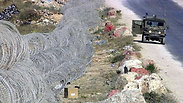Elections prompt politicians to promise more than they can deliver, whether it's a utopian peace or full annexation of Judea and Samaria.
Some of the factions, on the other hand, prefer to avoid staking a position on a final resolution of the Israeli-Palestinian conflict – their platform mired in a fog of war to avoid alienating any potential voters.
That is why I chose to publish a proposal as an alternative to the election gridlock on the pressing issue:
- There is no agreement that can be signed between the two people to put an end to the conflict between Israel and the Palestinians.
- The Zionist interest is to maximize territory while minimizing its Palestinian population.
- There is no status quo. It is an invention. The reality on the ground changes constantly. A Jerusalem that no one is governing will be lost.
- The international community – whether we like it or not – has a part to play in molding the reality on the ground. No people dwell alone.
- There is no Greater Israel – 40 percent of Judea and Samaria is under the control of the Palestinian Authority, and not a single Jew lives within that territory.
- An annexation of all of the territories requires full provision of citizenship to all Palestinians – resulting in massive economic damage (in social security payments and investment in infrastructure) and a threat to a bi-national state. Regardless of their population figure.
- Gaza is a separate enemy state which we have yet to comprehensively disengage from.
Now to the conclusions:
- Israel must separate from the Palestinians without gambling/conceding territory which may become part of Gaza.
- The choice is between a unilateral decision or a comprehensive regional process with cooperation with the United State and, if possible, European states which can think outside the box (of which there are at least two).
- The 1967 lines no longer exist.
How do we separate?
Bennett's separation plan is ideal, if it could only be implemented, and we could explain what would happen on the Palestinian side.
Omer Bar Lev's separation plan (returning to the settlement bloc lines) requires a senseless gamble.
A national separation plan – the proposal:
- Gradual annexation of settlement blocs (starting with Gush Etzion) – approximately 12 percent of the territory of Judea and Samaria.
- In return, the Palestinian Authority's status would be upgraded and its government granted contiguous territory based on Areas A and B.
- The Palestinian Authority would become a demilitarized state with temporary borders – if they want it could become the Palestinian empire.
- The territory outside of the settlement blocs and outside the PA's lands (48 percent) will be considered disputed territory. As of today, some 100,000 Israelis and 100,000 Palestinians live there. Each one will carry the citizenship of his state. Security supervision would remain in the hands of the IDF.
- The State of Israel will invest in construction in the settlement blocs and provide normal life for Israelis living outside the blocs. The PA and the international community will invest in Palestinian infrastructure.
- In any scenario of a military or terror threat, Israel would have the right to operate within all Palestinian lands to defend itself.
- The Palestinian Authority does not have to recognize Israel. There is no resolution to the conflict. There is no answer to the refugee issue or to Jerusalem. If the Palestinians can thrive in the temporary borders it will be possible to conduct negotiations. If not, that country will collapse.
- The neighborhoods outside the security barrier in Jerusalem (like the Qalandia and Shuafat refugee camps) – into which Israelis are barred to enter by military injunction – will be taken out of the Jerusalem municipal area. There is no sense in paying social security and providing citizenship to those residents.
- Vision for the future: A reduced Alon plan according to the construction on the ground.
Pros:
- Israeli initiative which advances both sides using small steps without significant peace treaties which are impossible to implement.
- Recognition of the limitations and the needs of the other side.
- Minimizing the demographic division between Israelis and Palestinians to 48 percent.
- Preventing a bi-national state.
- Normalizing the settlement blocs.
- No evacuations of settlements.
- Each side can develop its vision and its gradual plans.
- Announcement of the move as an interim step that means allowing for the possibility of future negotiations.
Cons:
- Palestinians continue activity in the international stage as a state.
- Palestinian terror (to which the IDF has the full right to respond).
- Objection from international players who support an Israeli withdrawal to the 1967 lines (this move being defined as an interim step).

















